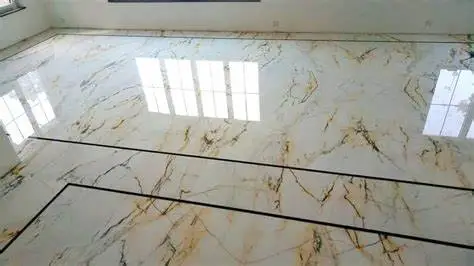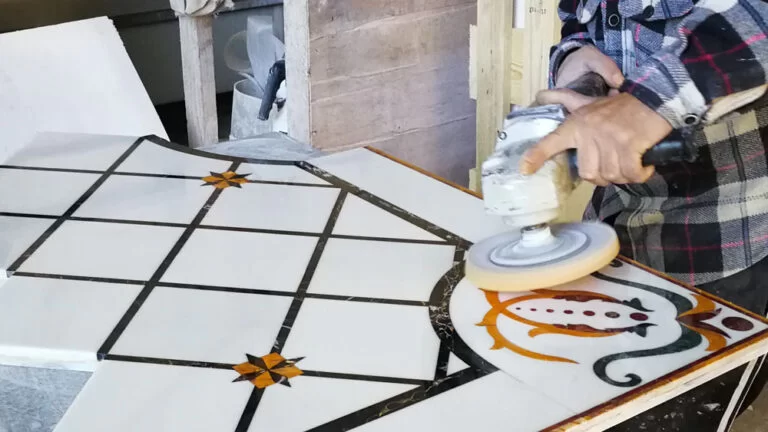
A marble slab is a symbol of timeless luxury, but even the most beautiful natural stone can lose its luster due to wear, dirt, or improper care
A marble slab is a symbol of timeless luxury, but even the most beautiful natural stone can lose its luster due to wear, dirt, or improper care. Fortunately, polishing your marble slab can restore its original shine and help preserve it for years to come. Whether it’s your kitchen countertop, bathroom vanity, backsplash, or flooring, regular polishing is key to maintaining marble’s stunning appearance and durability.
This comprehensive guide walks you through how to polish a marble slab—safely, efficiently, and affordably—whether you’re working with a white marble slab, Carrara marble, or engineered marble slab.

Why Does Marble Lose Its Shine?
Over time, marble slabs become dull due to:
- Dirt and grit causing micro-scratches
- Acidic spills (like lemon juice or vinegar) etching the surface
- Improper cleaning products
- Lack of sealing
- Heavy foot traffic (for marble slab flooring)
Regular polishing not only improves aesthetics but also protects the marble surface from damage.

Tools & Materials You’ll Need
To polish a marble slab at home, gather the following supplies:
- Mild marble-safe cleaner
- Soft microfiber cloths
- Fine-grit sandpaper or marble polishing powder
- Polishing pads or orbital buffer (for larger areas)
- Marble polishing compound or powder
- Sealant (for post-polish protection)
- Spray bottle with water
How to Polish a Marble Slab – Step-by-Step
1. Clean the Surface Thoroughly
Start with a deep clean:
- Use a pH-neutral marble cleaner or warm water with a few drops of gentle dish soap.
- Avoid acidic or abrasive cleaners—they damage marble finishes.
- Wipe with a clean microfiber cloth and let it dry completely.
2. Assess the Surface
Identify the type of finish:
- Polished marble slab: Glossy and reflective, commonly used for countertops and walls.
- Honed marble slab: Matte finish, often used in flooring and high-traffic areas.
Polished slabs require more precise polishing to restore their gloss.
3. Buff Minor Scratches
If your slab has small scratches:
- Lightly buff with 600-800 grit sandpaper.
- Always move in circular motions, applying minimal pressure.
- Clean residue with a damp cloth.
🔗 How to Repair Cracked Marble Slab
4. Apply Polishing Powder or Compound
You have two options:
Option A: Marble Polishing Powder
- Dampen the marble surface lightly.
- Sprinkle the powder and rub in with a cloth or felt pad.
- Continue polishing until shine reappears.
Option B: Marble Polishing Cream
- Apply a small amount directly onto the slab.
- Use a soft buffer pad or orbital polisher to spread evenly.
- Work in 2×2 ft sections for best results.
Repeat the process if the surface remains dull after the first round.
5. Buff with a Clean Cloth
- After polishing, use a dry microfiber cloth to buff the surface.
- Remove any excess product or haze.
This is especially important for black marble slab or green marble slab, where residue can be more visible.
6. Seal the Marble
Once polished:
- Apply a marble-safe sealer to protect the surface.
- Let it penetrate, then wipe off the excess.
- Sealing helps repel stains and moisture—especially important in marble slab bathrooms or kitchen countertops.
Polishing Specific Marble Applications
Polishing Marble Countertops
- Focus on food-safe, non-toxic polish.
- Avoid acidic substances like citrus or vinegar after polishing.
Polishing Marble Flooring
- Use a slow-speed buffer for large floor areas.
- Always remove furniture and debris before starting.
Polishing Marble Slab for Wall Cladding or Backsplash
- Use a cream or gel-based polish for vertical surfaces.
- Work in small sections to prevent drips or runs.
🔗 How to Install Marble Slab Backsplash
Tips to Maintain a Polished Marble Slab
- Use coasters and mats on countertops.
- Re-polish every 6–12 months depending on use.
- Reseal periodically to prevent stains and etching.
- Clean spills immediately—especially acidic or oily substances.
- Avoid dragging furniture or sharp items on marble slab floors.
Common Questions About Polishing Marble
Can I polish marble myself?
Yes! With the right tools and care, homeowners can polish marble slabs themselves.
Will polishing remove deep cracks?
No—cracks require epoxy repair before polishing. Learn more:
🔗 How to Repair Broken Marble Slab
Does polished marble need to be sealed?
Absolutely. Polishing restores shine, but sealing protects it.
Final Thoughts
Knowing how to polish a marble slab properly saves money, preserves your investment, and keeps your home looking luxurious. Whether you’re restoring Carrara marble slabs, Calafate marble, or a local marble slab, the process is straightforward and can be done with basic tools and a little patience.
Polishing enhances not only aesthetics but also your marble slab’s durability and resale value. For best results, combine polishing with a consistent maintenance routine and proper sealing.

